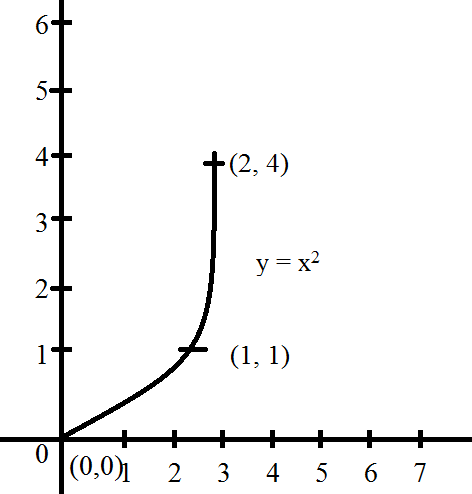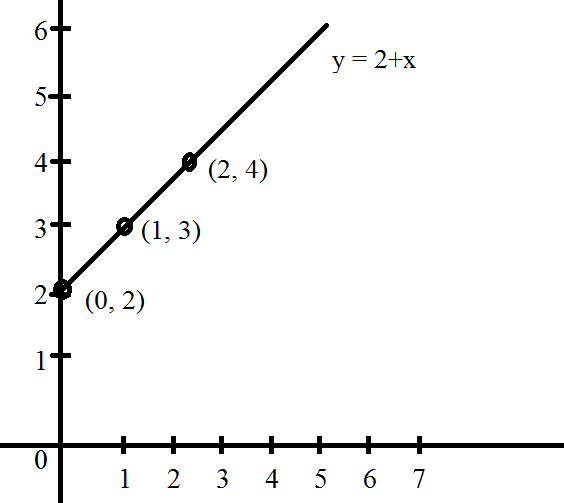
Draw the graphs of \[y = {x^2}\] and \[y = 2 + x\] solve the equation \[{x^2} - x - 2 = 0\]
Answer
573.6k+ views
Hint: The graph of a polynomial function is a smooth continuous curve or a line depending on the abscissa and ordinate variation.
Abscissa: In a system of coordinates the distance from a point to the vertical or y- axis, measured parallel to the horizontal or x-axis, the co-coordinate.
Ordinate: In a system of coordinates the distance from a point to the horizontal or x- axis, measured parallel to the vertical or y-axis, the y- coordinate.
i.e.\[\left( {x,y} \right) = \](abscissa, co-ordinate)
A graph can be obtained by putting different values of x and then obtaining different values of y.
Therefore,
Complete step by step answer:
Given \[y = {x^2}\]and \[y = 2 + x\]
For \[y = {x^2}\]
Put \[x = 0,y = {\left( 0 \right)^2} \Rightarrow y = 0\]
Put \[x = 1,y = {\left( 1 \right)^2} \Rightarrow y = 1\]
We have \[\left( {0,0} \right)and\left( {1,1} \right)\]
Put \[x = 2,y = {\left( 2 \right)^2} \Rightarrow y = 4\]
We have, \[\left( {2,4} \right)\]
Now plotting \[\left( {xy} \right)ie\left( {0,0} \right);\left( {1,1} \right);\left( {2,4} \right)\]in the graph for \[y = {x^2}\]

Hence, we see that \[y = {x^2}\]is a curve
For \[y = 2 + x\]
Put \[x = 0,y = 2 + 0 = 2,\] we have \[\left( {0,2} \right)\]
Put \[x = 1,y = 2 + 1 = 3\] we have \[\left( {1,3} \right)\]
Put \[x = 2,y = 2 + 2 = 4,\] we have \[\left( {2,4} \right)\]
Now plotting point \[\left( {x{\text{ }},{\text{ }}y} \right)\] i.e. \[\left( {0{\text{ }},2} \right)\]\[\left( {1,3} \right)\] \[\left( {2,4} \right)\] on the graph

Hence, we see that \[y = 2 + x\] is a straight line.
To solve \[{x^2} - x - 2 = 0\]
By middle term splitting, we have product of coefficient of \[{x^2}\] is \[1\] and constant \[ - 2\] is \[ - 2\] and we know sum of \[ - 2 + 1\] is \[ - 1\].
Hence, \[{x^2} - x - 2 = 0\]
\[ \Rightarrow {x^2} - 2x + x - 2 = 0\]
\[ \Rightarrow x\left( {x - 2} \right) + \left( {x - 2} \right) = 0\] [Taking common]
\[ \Rightarrow \left( {x - 2} \right)\left( {x + 1} \right) = 0\] [Taking \[ - 2\] common]
We have \[\left( {x - 2} \right) = 0\]and \[x + 1 = 0\]
\[x = 2andx = - 1\]
Note:
We can also solve equations like \[a{x^2} + bx + c\]by middle term splitting or by hit and trial method.
We can find the number of points in a graph.
Remember that x, and y are positive in Ist quadrant only.
Abscissa: In a system of coordinates the distance from a point to the vertical or y- axis, measured parallel to the horizontal or x-axis, the co-coordinate.
Ordinate: In a system of coordinates the distance from a point to the horizontal or x- axis, measured parallel to the vertical or y-axis, the y- coordinate.
i.e.\[\left( {x,y} \right) = \](abscissa, co-ordinate)
A graph can be obtained by putting different values of x and then obtaining different values of y.
Therefore,
Complete step by step answer:
Given \[y = {x^2}\]and \[y = 2 + x\]
For \[y = {x^2}\]
Put \[x = 0,y = {\left( 0 \right)^2} \Rightarrow y = 0\]
Put \[x = 1,y = {\left( 1 \right)^2} \Rightarrow y = 1\]
We have \[\left( {0,0} \right)and\left( {1,1} \right)\]
Put \[x = 2,y = {\left( 2 \right)^2} \Rightarrow y = 4\]
We have, \[\left( {2,4} \right)\]
Now plotting \[\left( {xy} \right)ie\left( {0,0} \right);\left( {1,1} \right);\left( {2,4} \right)\]in the graph for \[y = {x^2}\]

Hence, we see that \[y = {x^2}\]is a curve
For \[y = 2 + x\]
Put \[x = 0,y = 2 + 0 = 2,\] we have \[\left( {0,2} \right)\]
Put \[x = 1,y = 2 + 1 = 3\] we have \[\left( {1,3} \right)\]
Put \[x = 2,y = 2 + 2 = 4,\] we have \[\left( {2,4} \right)\]
Now plotting point \[\left( {x{\text{ }},{\text{ }}y} \right)\] i.e. \[\left( {0{\text{ }},2} \right)\]\[\left( {1,3} \right)\] \[\left( {2,4} \right)\] on the graph

Hence, we see that \[y = 2 + x\] is a straight line.
To solve \[{x^2} - x - 2 = 0\]
By middle term splitting, we have product of coefficient of \[{x^2}\] is \[1\] and constant \[ - 2\] is \[ - 2\] and we know sum of \[ - 2 + 1\] is \[ - 1\].
Hence, \[{x^2} - x - 2 = 0\]
\[ \Rightarrow {x^2} - 2x + x - 2 = 0\]
\[ \Rightarrow x\left( {x - 2} \right) + \left( {x - 2} \right) = 0\] [Taking common]
\[ \Rightarrow \left( {x - 2} \right)\left( {x + 1} \right) = 0\] [Taking \[ - 2\] common]
We have \[\left( {x - 2} \right) = 0\]and \[x + 1 = 0\]
\[x = 2andx = - 1\]
Note:
We can also solve equations like \[a{x^2} + bx + c\]by middle term splitting or by hit and trial method.
We can find the number of points in a graph.
Remember that x, and y are positive in Ist quadrant only.
Recently Updated Pages
Two men on either side of the cliff 90m height observe class 10 maths CBSE

What happens to glucose which enters nephron along class 10 biology CBSE

Cutting of the Chinese melon means A The business and class 10 social science CBSE

Write a dialogue with at least ten utterances between class 10 english CBSE

Show an aquatic food chain using the following organisms class 10 biology CBSE

A circle is inscribed in an equilateral triangle and class 10 maths CBSE

Trending doubts
Why is there a time difference of about 5 hours between class 10 social science CBSE

Write a letter to the principal requesting him to grant class 10 english CBSE

What is the median of the first 10 natural numbers class 10 maths CBSE

The Equation xxx + 2 is Satisfied when x is Equal to Class 10 Maths

Which of the following does not have a fundamental class 10 physics CBSE

State and prove converse of BPT Basic Proportionality class 10 maths CBSE




